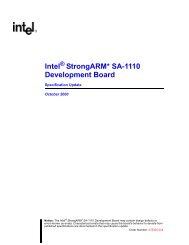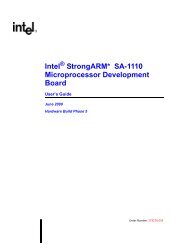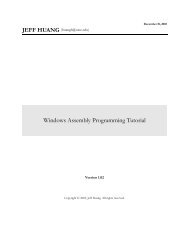Beej's Guide to Network Programming Using Internet Sockets
Beej's Guide to Network Programming Using Internet Sockets
Beej's Guide to Network Programming Using Internet Sockets
- No tags were found...
You also want an ePaper? Increase the reach of your titles
YUMPU automatically turns print PDFs into web optimized ePapers that Google loves.
Beej’s <strong>Guide</strong> <strong>to</strong> <strong>Network</strong> <strong>Programming</strong> <strong>Using</strong> <strong>Internet</strong> <strong>Sockets</strong> 11. IntroHey! Socket programming got you down? Is this stuff just a little <strong>to</strong>o difficult <strong>to</strong> figure outfrom the man pages? You want <strong>to</strong> do cool <strong>Internet</strong> programming, but you don’t have time <strong>to</strong> wadethrough a gob of structs trying <strong>to</strong> figure out if you have <strong>to</strong> call bind() before you connect(),etc., etc.Well, guess what! I’ve already done this nasty business, and I’m dying <strong>to</strong> share the informationwith everyone! You’ve come <strong>to</strong> the right place. This document should give the average competentC programmer the edge s/he needs <strong>to</strong> get a grip on this networking noise.1.1. AudienceThis document has been written as a tu<strong>to</strong>rial, not a reference. It is probably at its best when readby individuals who are just starting out with socket programming and are looking for a foothold.It is certainly not the complete guide <strong>to</strong> sockets programming, by any means.Hopefully, though, it’ll be just enough for those man pages <strong>to</strong> start making sense... :-)1.2. Platform and CompilerThe code contained within this document was compiled on a Linux PC using Gnu’s gcccompiler. It should, however, build on just about any platform that uses gcc. Naturally, this doesn’tapply if you’re programming for Windows–see the section on Windows programming, below.1.3. Official HomepageThis official location of this document is http://beej.us/guide/bgnet/.1.4. Note for Solaris/SunOS ProgrammersWhen compiling for Solaris or SunOS, you need <strong>to</strong> specify some extra command-line switchesfor linking in the proper libraries. In order <strong>to</strong> do this, simply add “-lnsl -lsocket -lresolv”<strong>to</strong> the end of the compile command, like so:$ cc -o server server.c -lnsl -lsocket -lresolvIf you still get errors, you could try further adding a “-lxnet” <strong>to</strong> the end of that commandline. I don’t know what that does, exactly, but some people seem <strong>to</strong> need it.Another place that you might find problems is in the call <strong>to</strong> setsockopt(). The pro<strong>to</strong>typediffers from that on my Linux box, so instead of:int yes=1;enter this:char yes=’1’;As I don’t have a Sun box, I haven’t tested any of the above information–it’s just what peoplehave <strong>to</strong>ld me through email.1.5. Note for Windows ProgrammersI have a particular dislike for Windows, and encourage you <strong>to</strong> try Linux, BSD, or Unix instead.That being said, you can still use this stuff under Windows.












